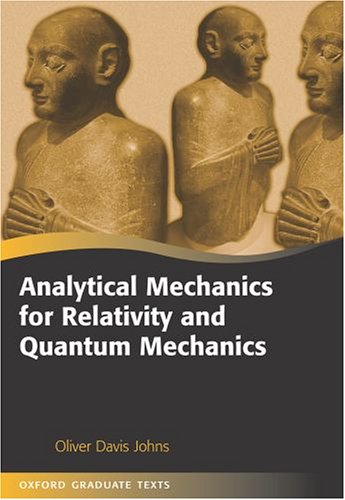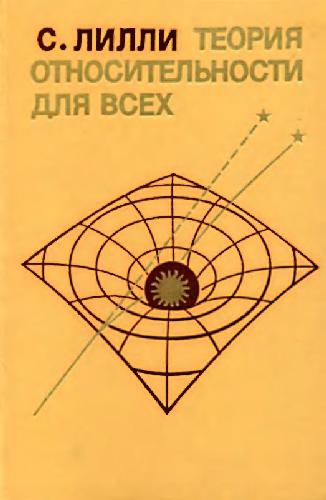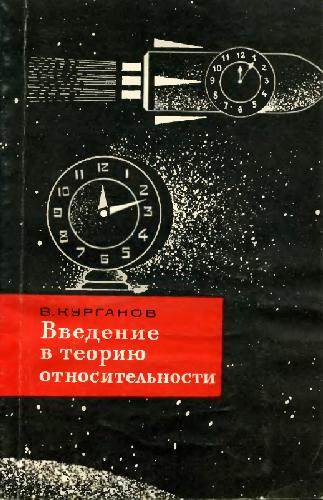Oliver Johns0-19-856726-X, 978-0-19-856726-4
Table of contents :
Contents……Page 12
Dedication……Page 6
Preface……Page 8
Acknowledgments……Page 10
PART I: INTRODUCTION: THE TRADITIONAL THEORY……Page 22
1.1 Newton’s Space and Time……Page 24
1.2 Single Point Particle……Page 26
1.3 Collective Variables……Page 27
1.4 The Law of Momentum for Collections……Page 28
1.5 The Law of Angular Momentum for Collections……Page 29
1.6 “Derivations” of the Axioms……Page 30
1.7 The Work–Energy Theorem for Collections……Page 31
1.9 The Center of Mass……Page 32
1.10 Center of Mass and Momentum……Page 34
1.11 Center of Mass and Angular Momentum……Page 35
1.13 Change of Angular Momentum……Page 36
1.14 Center of Mass and the Work–Energy Theorems……Page 37
1.16 Special Results for Rigid Bodies……Page 38
1.17 Exercises……Page 39
2.1 Configuration Space……Page 45
2.2 Newton’s Second Law in Lagrangian Form……Page 47
2.4 Arbitrary Generalized Coordinates……Page 48
2.6 Generalized Forces in the q-System……Page 50
2.7 The Lagrangian Expressed in the q-System……Page 51
2.8 Two Important Identities……Page 52
2.9 Invariance of the Lagrange Equations……Page 53
2.10 Relation Between Any Two Systems……Page 54
2.11 More of the Simple Example……Page 55
2.13 Ignorable Coordinates……Page 56
2.15 The Generalized Energy Function……Page 57
2.16 The Generalized Energy and the Total Energy……Page 58
2.17 Velocity Dependent Potentials……Page 59
2.18 Exercises……Page 62
3.1 Constraints Defined……Page 67
3.2 Virtual Displacement……Page 68
3.3 Virtual Work……Page 69
3.4 Form of the Forces of Constraint……Page 71
3.5 General Lagrange Equations with Constraints……Page 73
3.6 An Alternate Notation for Holonomic Constraints……Page 74
3.8 Reduction of Degrees of Freedom……Page 75
3.9 Example of a Reduction……Page 78
3.10 Example of a Simpler Reduction Method……Page 79
3.11 Recovery of the Forces of Constraint……Page 80
3.12 Example of a Recovery……Page 81
3.13 Generalized Energy Theorem with Constraints……Page 82
3.14 Tractable Non-Holonomic Constraints……Page 84
3.15 Exercises……Page 85
4.1 Phase Space……Page 92
4.2 Hamilton Equations……Page 95
4.3 An Example of the Hamilton Equations……Page 97
4.4 Non-Potential and Constraint Forces……Page 98
4.5 Reduced Hamiltonian……Page 99
4.6 Poisson Brackets……Page 101
4.7 The Schroedinger Equation……Page 103
4.8 The Ehrenfest Theorem……Page 104
4.9 Exercises……Page 105
5 The Calculus of Variations……Page 109
5.1 Paths in an N-Dimensional Space……Page 110
5.2 Variations of Coordinates……Page 111
5.3 Variations of Functions……Page 112
5.4 Variation of a Line Integral……Page 113
5.5 Finding Extremum Paths……Page 115
5.6 Example of an Extremum Path Calculation……Page 116
5.7 Invariance and Homogeneity……Page 119
5.8 The Brachistochrone Problem……Page 121
5.9 Calculus of Variations with Constraints……Page 123
5.10 An Example with Constraints……Page 126
5.11 Reduction of Degrees of Freedom……Page 127
5.12 Example of a Reduction……Page 128
5.14 The Coordinate Parametric Method……Page 129
5.15 Comparison of the Methods……Page 132
5.16 Exercises……Page 134
6.1 Hamilton’s Principle in Lagrangian Form……Page 138
6.2 Hamilton’s Principle with Constraints……Page 139
6.3 Comments on Hamilton’s Principle……Page 140
6.4 Phase-Space Hamilton’s Principle……Page 141
6.5 Exercises……Page 143
7.1 Definition of Operators……Page 144
7.2 Operators and Matrices……Page 146
7.4 Determinant, Trace, and Inverse……Page 148
7.5 Special Operators……Page 150
7.6 Dyadics……Page 151
7.8 Operators, Components, Matrices, and Dyadics……Page 154
7.9 Complex Vectors and Operators……Page 155
7.11 Eigenvectors and Eigenvalues……Page 157
7.13 Eigenvectors of Real Anti-Symmetric Operator……Page 158
7.14 Normal Operators……Page 160
7.15 Determinant and Trace of Normal Operator……Page 162
7.16 Eigen-Dyadic Expansion of Normal Operator……Page 163
7.17 Functions of Normal Operators……Page 164
7.18 The Exponential Function……Page 166
7.19 The Dirac Notation……Page 167
7.20 Exercises……Page 168
8.1 Characterization of Rigid Bodies……Page 173
8.2 The Center of Mass of a Rigid Body……Page 174
8.3 General Definition of Rotation Operator……Page 176
8.4 Rotation Matrices……Page 178
8.6 Proper and Improper Rotation Operators……Page 179
8.7 The Rotation Group……Page 181
8.8 Kinematics of a Rigid Body……Page 182
8.9 Rotation Operators and Rigid Bodies……Page 184
8.10 Differentiation of a Rotation Operator……Page 185
8.11 Meaning of the Angular Velocity Vector……Page 187
8.12 Velocities of the Masses of a Rigid Body……Page 189
8.13 Savio’s Theorem……Page 190
8.14 Infinitesimal Rotation……Page 191
8.15 Addition of Angular Velocities……Page 192
8.16 Fundamental Generators of Rotations……Page 193
8.17 Rotation with a Fixed Axis……Page 195
8.18 Expansion of Fixed-Axis Rotation……Page 197
8.19 Eigenvectors of the Fixed-Axis Rotation Operator……Page 199
8.20 The Euler Theorem……Page 200
8.22 Rotation of the Fundamental Generators……Page 202
8.23 Rotation of a Fixed-Axis Rotation……Page 203
8.24 Parameterization of Rotation Operators……Page 204
8.25 Differentiation of Parameterized Operator……Page 205
8.26 Euler Angles……Page 206
8.27 Fixed-Axis Rotation from Euler Angles……Page 209
8.28 Time Derivative of a Product……Page 210
8.29 Angular Velocity from Euler Angles……Page 211
8.30 Active and Passive Rotations……Page 212
8.31 Passive Transformation of Vector Components……Page 213
8.32 Passive Transformation of Matrix Elements……Page 214
8.33 The Body Derivative……Page 215
8.34 Passive Rotations and Rigid Bodies……Page 216
8.35 Passive Use of Euler Angles……Page 217
8.36 Exercises……Page 219
9.1 Basic Facts of Rigid-Body Motion……Page 223
9.2 The Inertia Operator and the Spin……Page 224
9.3 The Inertia Dyadic……Page 225
9.5 Meaning of the Inertia Operator……Page 226
9.6 Principal Axes……Page 227
9.7 Guessing the Principal Axes……Page 229
9.8 Time Evolution of the Spin……Page 231
9.9 Torque-Free Motion of a Symmetric Body……Page 232
9.10 Euler Angles of the Torque-Free Motion……Page 236
9.11 Body with One Point Fixed……Page 238
9.12 Preserving the Principal Axes……Page 241
9.14 Body with One Point Fixed, Alternate Derivation……Page 242
9.15 Work–Energy Theorems……Page 243
9.16 Rotation with a Fixed Axis……Page 244
9.17 The Symmetric Top with One Point Fixed……Page 245
9.18 The Initially Clamped Symmetric Top……Page 250
9.19 Approximate Treatment of the Symmetric Top……Page 251
9.20 Inertial Forces……Page 252
9.21 Laboratory on the Surface of the Earth……Page 255
9.22 Coriolis Force Calculations……Page 257
9.23 The Magnetic – Coriolis Analogy……Page 258
9.24 Exercises……Page 260
10.1 Equilibrium Defined……Page 267
10.2 Finding Equilibrium Points……Page 268
10.3 Small Coordinates……Page 269
10.4 Normal Modes……Page 270
10.5 Generalized Eigenvalue Problem……Page 271
10.7 Initial Conditions……Page 273
10.8 The Energy of Small Vibrations……Page 274
10.9 Single Mode Excitations……Page 275
10.10 A Simple Example……Page 276
10.11 Zero-Frequency Modes……Page 281
10.12 Exercises……Page 282
PART II: MECHANICS WITH TIME AS A COORDINATE……Page 286
11 Lagrangian Mechanics with Time as a Coordinate……Page 288
11.2 A Change of Notation……Page 289
11.3 Extended Lagrangian……Page 290
11.4 Extended Momenta……Page 291
11.5 Extended Lagrange Equations……Page 293
11.6 A Simple Example……Page 294
11.7 Invariance Under Change of Parameter……Page 296
11.8 Change of Generalized Coordinates……Page 297
11.9 Redundancy of the Extended Lagrange Equations……Page 298
11.10 Forces of Constraint……Page 299
11.11 Reduced Lagrangians with Time as a Coordinate……Page 302
11.12 Exercises……Page 303
12.2 Dependency Relation……Page 306
12.3 Only One Dependency Relation……Page 307
12.4 From Traditional to Extended Hamiltonian Mechanics……Page 309
12.5 Equivalence to Traditional Hamilton Equations……Page 311
12.6 Example of Extended Hamilton Equations……Page 312
12.7 Equivalent Extended Hamiltonians……Page 313
12.8 Alternate Hamiltonians……Page 314
12.10 Not a Legendre Transformation……Page 316
12.11 Dirac’s Theory of Phase-Space Constraints……Page 317
12.12 Poisson Brackets with Time as a Coordinate……Page 319
12.13 Poisson Brackets and Quantum Commutators……Page 321
12.14 Exercises……Page 323
13.1 Extended Hamilton’s Principle……Page 326
13.2 Noether’s Theorem……Page 328
13.3 Examples of Noether’s Theorem……Page 329
13.4 Hamilton’s Principle in an Extended Phase Space……Page 331
13.5 Exercises……Page 333
14.1 Galilean Relativity……Page 334
14.2 Conflict with the Aether……Page 336
14.3 Einsteinian Relativity……Page 337
14.4 What Is a Coordinate System?……Page 339
14.5 A Survey of Spacetime……Page 340
14.6 The Lorentz Transformation……Page 352
14.7 The Principle of Relativity……Page 358
14.8 Lorentzian Relativity……Page 360
14.9 Mechanism and Relativity……Page 361
14.10 Exercises……Page 362
15.1 Fourvectors……Page 364
15.2 Inner Product……Page 367
15.4 Relativistic Interval……Page 368
15.5 Spacetime Diagram……Page 370
15.6 General Fourvectors……Page 371
15.7 Construction of New Fourvectors……Page 372
15.8 Covariant and Contravariant Components……Page 373
15.9 General Lorentz Transformations……Page 376
15.10 Transformation of Components……Page 377
15.11 Examples of Lorentz Transformations……Page 379
15.12 Gradient Fourvector……Page 381
15.13 Manifest Covariance……Page 382
15.15 The Lorentz Group……Page 383
15.17 Parameterization……Page 385
15.18 Fourvector Operators……Page 387
15.19 Fourvector Dyadics……Page 388
15.20 Wedge Products……Page 389
15.21 Scalar, Fourvector, and Operator Fields……Page 390
15.22 Manifestly Covariant Form of Maxwell’s Equations……Page 391
15.23 Exercises……Page 394
16.1 Modification of Newton’s Laws……Page 397
16.3 Fourvector Form of Newton’s Second Law……Page 399
16.5 Particles of Zero Mass……Page 401
16.6 Traditional Lagrangian……Page 402
16.8 Invariant Lagrangian……Page 404
16.9 Manifestly Covariant Lagrange Equations……Page 405
16.10 Momentum Fourvectors and Canonical Momenta……Page 406
16.11 Extended Hamiltonian……Page 407
16.12 Invariant Hamiltonian……Page 408
16.13 Manifestly Covariant Hamilton Equations……Page 409
16.14 The Klein–Gordon Equation……Page 410
16.15 The Dirac Equation……Page 411
16.16 The Manifestly Covariant N-Body Problem……Page 413
16.17 Covariant Serret–Frenet Theory……Page 420
16.18 Fermi–Walker Transport……Page 422
16.19 Example of Fermi–Walker Transport……Page 424
16.20 Exercises……Page 426
17.1 Definition of Canonical Transformations……Page 432
17.3 Symplectic Coordinates……Page 433
17.4 Symplectic Matrix……Page 437
17.5 Standard Equations in Symplectic Form……Page 438
17.6 Poisson Bracket Condition……Page 439
17.7 Inversion of Canonical Transformations……Page 440
17.8 Direct Condition……Page 441
17.9 Lagrange Bracket Condition……Page 443
17.10 The Canonical Group……Page 444
17.11 Form Invariance of Poisson Brackets……Page 445
17.12 Form Invariance of the Hamilton Equations……Page 447
17.13 Traditional Canonical Transformations……Page 449
17.14 Exercises……Page 451
18.1 Proto-Generating Functions……Page 455
18.2 Generating Functions of the F1 Type……Page 457
18.3 Generating Functions of the F2 Type……Page 459
18.4 Examples of Generating Functions……Page 460
18.5 Other Simple Generating Functions……Page 462
18.6 Mixed Generating Functions……Page 463
18.7 Example of a Mixed Generating Function……Page 465
18.8 Finding Simple Generating Functions……Page 466
18.9 Finding Mixed Generating Functions……Page 467
18.10 Finding Mixed Generating Functions—An Example……Page 469
18.11 Traditional Generating Functions……Page 470
18.12 Standard Form of Extended Hamiltonian Recovered……Page 472
18.13 Differential Canonical Transformations……Page 473
18.14 Active Canonical Transformations……Page 474
18.15 Phase-Space Analog of Noether Theorem……Page 475
18.16 Liouville Theorem……Page 476
18.17 Exercises……Page 477
19.1 Definition of the Action……Page 482
19.2 Momenta from the S[sub(1)] Action Function……Page 483
19.3 The S[sub(2)] Action Function……Page 485
19.4 Example of S[sub(1)] and S[sub(2)] Action Functions……Page 486
19.5 The Hamilton–Jacobi Equation……Page 487
19.6 Hamilton’s Characteristic Equations……Page 488
19.7 Complete Integrals……Page 490
19.8 Separation of Variables……Page 493
19.9 Canonical Transformations……Page 494
19.10 General Integrals……Page 496
19.11 Mono-Energetic Integrals……Page 501
19.12 The Optical Analogy……Page 503
19.14 Schroedinger and Hamilton–Jacobi Equations……Page 504
19.15 The Quantum Cauchy Problem……Page 506
19.16 The Bohm Hidden Variable Model……Page 507
19.17 Feynman Path-Integral Technique……Page 508
19.18 Quantum and Classical Mechanics……Page 509
19.19 Exercises……Page 510
PART III: MATHEMATICAL APPENDICES……Page 514
A.2 Dot Product……Page 516
A.4 Linearity……Page 517
A.5 Cartesian Basis……Page 518
A.6 The Position Vector……Page 519
A.8 Polar Coordinates……Page 520
A.10 Miscellaneous Vector Formulae……Page 523
A.11 Gradient Vector Operator……Page 525
A.12 The Serret–Frenet Formulae……Page 526
B.2 Transposed Matrix……Page 529
B.4 Square, Symmetric, and Hermitian Matrices……Page 530
B.5 Algebra of Matrices: Addition……Page 531
B.6 Algebra of Matrices: Multiplication……Page 532
B.7 Diagonal and Unit Matrices……Page 533
B.10 Determinants of Square Matrices……Page 534
B.11 Properties of Determinants……Page 535
B.13 Expansion of a Determinant by Cofactors……Page 536
B.14 Inverses of Nonsingular Matrices……Page 537
B.15 Partitioned Matrices……Page 538
B.16 Cramer’s Rule……Page 539
B.17 Minors and Rank……Page 540
B.19 Homogeneous Linear Equations……Page 541
B.20 Inner Products of Column Vectors……Page 542
B.22 Orthogonal and Unitary Matrices……Page 544
B.23 Eigenvalues and Eigenvectors of Matrices……Page 545
B.24 Eigenvectors of Real Symmetric Matrix……Page 546
B.26 Normal Matrices……Page 549
B.27 Properties of Normal Matrices……Page 551
B.28 Functions of Normal Matrices……Page 554
C.1 Positive-Definite Matrices……Page 555
C.2 Generalization of the Real Inner Product……Page 556
C.3 The Generalized Eigenvalue Problem……Page 557
C.4 Finding Eigenvectors in the Generalized Problem……Page 558
C.5 Uses of the Generalized Eigenvectors……Page 559
D.2 Regions of Definition of Functions……Page 561
D.5 The Same Function in Different Coordinates……Page 562
D.6 Partial Derivatives……Page 563
D.9 Chain Rule……Page 564
D.11 Orders of Smallness……Page 565
D.13 Differential of a Function of Several Variables……Page 566
D.15 Differentials of Second and Higher Orders……Page 567
D.16 Taylor Series……Page 568
D.18 Differential Expressions……Page 569
D.20 Perfect Differentials……Page 571
D.21 Perfect Differential and Path Independence……Page 573
D.22 Jacobians……Page 574
D.23 Global Inverse Function Theorem……Page 577
D.24 Local Inverse Function Theorem……Page 580
D.25 Derivatives of the Inverse Functions……Page 581
D.27 Derivatives of Implicit Functions……Page 582
D.28 Functional Independence……Page 583
D.30 Legendre Transformations……Page 584
D.32 Derivatives of Homogeneous Functions……Page 586
D.34 Lagrange Multipliers……Page 587
D.35 Geometry of the Lagrange Multiplier Theorem……Page 590
D.36 Coupled Differential Equations……Page 591
D.37 Surfaces and Envelopes……Page 593
E.1 Abstract Vector Space……Page 596
E.2 Subspaces……Page 598
E.3 Linear Operators……Page 599
E.4 Vectors in Phase Space……Page 601
E.5 Canonical Transformations in Phase Space……Page 602
E.7 A Special Canonical Transformation……Page 603
E.8 Special Self-Orthogonal Subspaces……Page 604
E.9 Arnold’s Theorem……Page 606
E.10 Existence of a Mixed Generating Function……Page 607
References……Page 609
C……Page 612
F……Page 613
H……Page 614
L……Page 615
P……Page 616
S……Page 617
Z……Page 618







Reviews
There are no reviews yet.